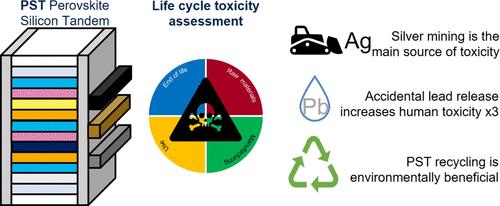当前位置:
X-MOL 学术
›
ACS Sustain. Chem. Eng.
›
论文详情
Our official English website, www.x-mol.net, welcomes your
feedback! (Note: you will need to create a separate account there.)
Comparative Life Cycle Toxicity Assessment of Perovskite/Silicon Tandem Photovoltaics
ACS Sustainable Chemistry & Engineering ( IF 7.1 ) Pub Date : 2024-11-16 , DOI: 10.1021/acssuschemeng.4c06264 Gonzalo Rodriguez-Garcia, Jon J. Kellar, Zhengtao Zhu, Erkan Aydin, Stefaan De Wolf, Ilke Celik
ACS Sustainable Chemistry & Engineering ( IF 7.1 ) Pub Date : 2024-11-16 , DOI: 10.1021/acssuschemeng.4c06264 Gonzalo Rodriguez-Garcia, Jon J. Kellar, Zhengtao Zhu, Erkan Aydin, Stefaan De Wolf, Ilke Celik

|
Perovskite/silicon tandem solar cells (PSTs) have emerged as promising photovoltaic (PV) technology that can exceed the theoretical power conversion efficiency limit of single-junction solar cells. To determine the future potential benefits of PSTs, it is crucial to accurately assess their environmental impacts and recyclability. Here, we present the first complete life cycle toxicity assessment of the PST panels. For this, we evaluated the toxicity of material procurement, manufacturing, and use stages and compared them with the toxicity of crystalline silicon PVs and CdTe PVs, as well as other electricity sources. For the end-of-life (EoL) stage, we developed three variants of panel recycling processes and compared their toxicity impacts with those of procuring the materials required to manufacture a new panel. We found that the life cycle toxicity of PV sin general is mainly driven by metal emissions. PSTs in particular emit more metals (and these are more toxic) than other PVs, but less than conventional sources of energy. A lower silver content─or more sustainable silver procurement─would be the first step toward making PSTs more environmentally sustainable. Concerning the EoL analysis, all proposed variants are less impactful than materials procured from the market. Their largest benefits can be found in the recovery of the bottom glass and crystalline silicon subcell, the copper cables, and the top glass.
中文翻译:

钙钛矿/硅叠层光伏的比较生命周期毒性评估
钙钛矿/硅叠层太阳能电池 (PST) 已成为一种前景广阔的光伏 (PV) 技术,可以超过单结太阳能电池的理论功率转换效率极限。为了确定 PST 的未来潜在好处,准确评估其环境影响和可回收性至关重要。在这里,我们提出了 PST 面板的第一次完整生命周期毒性评估。为此,我们评估了材料采购、制造和使用阶段的毒性,并将其与晶体硅 PV 和 CdTe PV 以及其他电源的毒性进行了比较。对于报废 (EoL) 阶段,我们开发了三种面板回收工艺的变体,并将它们的毒性影响与采购制造新面板所需材料的影响进行了比较。我们发现 PV sin 的生命周期毒性一般主要由金属排放驱动。特别是 PST 比其他 PV 排放更多的金属(而且这些金属的毒性更大),但比传统能源少。较低的银含量或更可持续的银采购将是使 PST 更具环境可持续性的第一步。关于 EoL 分析,所有提议的变体都比从市场上采购的材料影响小。它们的最大好处在于回收底部玻璃和晶体硅子电池、铜电缆和顶部玻璃。
更新日期:2024-11-16
中文翻译:

钙钛矿/硅叠层光伏的比较生命周期毒性评估
钙钛矿/硅叠层太阳能电池 (PST) 已成为一种前景广阔的光伏 (PV) 技术,可以超过单结太阳能电池的理论功率转换效率极限。为了确定 PST 的未来潜在好处,准确评估其环境影响和可回收性至关重要。在这里,我们提出了 PST 面板的第一次完整生命周期毒性评估。为此,我们评估了材料采购、制造和使用阶段的毒性,并将其与晶体硅 PV 和 CdTe PV 以及其他电源的毒性进行了比较。对于报废 (EoL) 阶段,我们开发了三种面板回收工艺的变体,并将它们的毒性影响与采购制造新面板所需材料的影响进行了比较。我们发现 PV sin 的生命周期毒性一般主要由金属排放驱动。特别是 PST 比其他 PV 排放更多的金属(而且这些金属的毒性更大),但比传统能源少。较低的银含量或更可持续的银采购将是使 PST 更具环境可持续性的第一步。关于 EoL 分析,所有提议的变体都比从市场上采购的材料影响小。它们的最大好处在于回收底部玻璃和晶体硅子电池、铜电缆和顶部玻璃。


















































 京公网安备 11010802027423号
京公网安备 11010802027423号